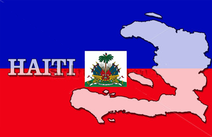
Haitian cuisine originates from several culinary styles from the various historical ethnic groups that populated the western portion of the island of Hispaniola, namely the French, African, and the indigenous Taíno Indians. Haitian cuisine is similar to the rest of the Latin-Caribbean (French and Spanish-speaking countries of the Antilles) however it differs in several ways from its regional counterparts. Its primary influence derive from French cuisine, and African cuisine, with notable derivatives from native Taíno and Spanish culinary technique. Though similar to other cooking styles in the region, it carries a uniqueness native only to the country and an appeal to many visitors to the island. Haitians often use peppers and other strong flavorings.
Dishes tend to be seasoned liberally and consequently Haitian cuisine is often moderately spicy, not mild and not too hot. In the country, however, many businesses of foreign origin have been established introducing several foreign cuisines into the mainstream culture. Years of adaptation have led to these cuisines (ie: Levantine from Arab migration to Haiti) to merge into Haitian cuisine. Rice and beans in several differing ways are eaten throughout the country regardless of location, becoming a sort of national dish. They form the staple diet, which consists of a lot of starch and is high in carbohydrates. Rural areas, with better access to agricultural products, have a larger variety of choices.
One such dish is mais moulu (mayi moulin), which is comparable to cornmeal that can be eaten with sauce aux pois (sòs pwa), a bean sauce made from one of many types of beans such as kidney, pinto, chickpeas, or pigeon peas (known in some countries as gandules). Mais moulin can be eaten with fish (often red snapper), or alone depending on personal preference. Some of the many plants used in Haitian dishes include tomato, oregano, cabbage, avocado, bell peppers. A popular food is banane pesée (ban-nan'n peze), flattened plantain slices fried in soybean oil (known as tostones in the Dominican Republic and Puerto Rico). It is eaten both as a snack, part of a meal and is often eaten with tassot or griot, which are deep-fried goat and pork respectively.
Dishes tend to be seasoned liberally and consequently Haitian cuisine is often moderately spicy, not mild and not too hot. In the country, however, many businesses of foreign origin have been established introducing several foreign cuisines into the mainstream culture. Years of adaptation have led to these cuisines (ie: Levantine from Arab migration to Haiti) to merge into Haitian cuisine. Rice and beans in several differing ways are eaten throughout the country regardless of location, becoming a sort of national dish. They form the staple diet, which consists of a lot of starch and is high in carbohydrates. Rural areas, with better access to agricultural products, have a larger variety of choices.
One such dish is mais moulu (mayi moulin), which is comparable to cornmeal that can be eaten with sauce aux pois (sòs pwa), a bean sauce made from one of many types of beans such as kidney, pinto, chickpeas, or pigeon peas (known in some countries as gandules). Mais moulin can be eaten with fish (often red snapper), or alone depending on personal preference. Some of the many plants used in Haitian dishes include tomato, oregano, cabbage, avocado, bell peppers. A popular food is banane pesée (ban-nan'n peze), flattened plantain slices fried in soybean oil (known as tostones in the Dominican Republic and Puerto Rico). It is eaten both as a snack, part of a meal and is often eaten with tassot or griot, which are deep-fried goat and pork respectively.



